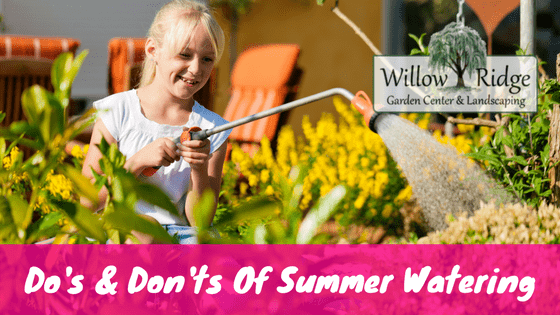The Do’s & Don’ts Of Summer Watering!
It’s Hot, Hot, Hot! The temperatures are in the 90’s and threatening to reach 100! High Summer is the time that we all have to protect our flowers, lawns and gardens. We can do this by making sure that they get the proper amount of water to flourish. I’m going to go over some of the do’s and don’ts of Summer watering.
Do: Water In The Morning
The best time to water your lawn, flower beds, vegetable gardens is early. Ideally between 4am and 9am. I know you have to be a pretty dedicated gardener to get up at 4am to water your plants. However, if you have an irrigation system with a timer, this is the time to water. Many of us water when we get home at night. The biggest problem with this, is that the night time temperatures frequently remain in the 70’s. If warm water remains on the plant leaves overnight, it provides an opportunity for fungus and diseases to develop. This is particularly true with zinnias, tomatoes and periwinkles, to name just three.
Don’t: Water in short spurts
What do you think would be better, watering you plants every day in the summer heat or giving them a good soaking a couple of times a week? Those of you that chose soaking win! Brief watering establishes shallow root systems, which are more likely to suffer from drought later.
The ideal situation is to have an irrigation system that is on a timer. If you don’t have an irrigation system, soaker hoses are a simple and inexpensive option. The exception to the soaker rule is potted plants and container plants. They are much more susceptible to evaporation and will most likely need watering on a daily basis. Impatiens need lots of water, but they let you know by wilting away. Give them a drink and they spring right back. Petunias, on the other hand, can prosper longer without as much water. Still, it’s best to water your containers daily unless you’ve gotten a good soaking rain.
Do: Remember your spring plantings
Established shrubs and trees don’t need as much watering as flower and vegetables gardens. That doesn’t mean they won’t need watering during the summer, however they are established and have deeper root systems to find the water further down. New spring plantings won’t have that deep root system that the mature plants have and are susceptible to dying if they aren’t given adequate water. A slow watering of the root zone by placing a hose that just oozes water will water the roots well and reduce wilting. Do this twice a week in drought conditions. So, don’t forget your new shrubs and trees!
Do: Adjust amounts according to rainfall
If you’re a serious gardener, or just someone that likes to keep track of things, you should have a rain gauge near your garden. Soil should be kept moist about six inches to eight inches deep. This requires about one inch of combined rainfall and applied watering every week. You use the rain gauge to determine how much watering you have to do. If you’ve gotten an inch of rain in the gauge at the end of the week, only the pots and containers will need your attention. If you have an irrigation system with an automatic timer, it will need to be adjusted according to the amount of rain fall you get.

